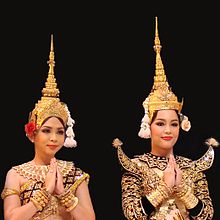Makuṭa

The chada (Thai: ชฎา), magaik (Burmese: မကိုဋ်), mongkut (Thai: มงกุฎ) and mokot (Khmer: មកុដ) are headdresses used as crowns in the mainland Southeast Asian monarchies of today's Thailand, Cambodia and (historically) Laos and Myanmar, and in classical court dances including khon/khol and the various forms of lakhon. They feature a tall pointed shape, are made of gold or a substitute, and are usually decorated with gemstones.
Etymology and origins
Chada is derived from Pali/Sanskrit jaṭā, while magaik, mongkut, and mokot are derived from Pali/Sanskrit makuṭa. The chada and mongkut originated as headdresses symbolizing the jaṭāmakuṭa, the matted hair of an ascetic formed into the shape of a crown, often found in the iconography of Shiva and Avalokiteśvara.[1][2] During the Ayutthaya period, the chada and mongkut acquired the distinctive tall pointed shape from the lomphok, a pointed cloth headdress of Persian origin.[3]
Variants

In Thai classical dance, the chada is worn by male characters of royal status, while the mongkut is worn by females. In the Cambodian tradition, both are referred to as mokot, distinguished as mokot ksat for males and mokot ksatrey for females. There are many variants of chada and mongkut, reflecting the status of the wearer as well as the occasion. As a symbol of divinity, the mongkut often appears in the iconography of the Buddha and in artistic depictions of devata (divine beings). It is also a symbol of kingship; the highest ranking mongkut is featured in the royal regalia of both Thailand and Cambodia as the Great Crown of Victory (Phra Maha Phichai Mongkut in Thai, Preah Moha Mokot Reach in Cambodian).
In pre-colonial Burmese kingdoms, the magaik was one of the five articles of regalia used during coronation ceremonies. The magaik also crowns prominent images of the Buddha. The magaik form of the hti, an umbrella that crowns Burmese pagodas, has nine tiers.[4] In modern-day Myanmar, the magaik is worn by dancers when performing classical forms of Burmese dance.
Gallery
-
Princess Voralaksanavadi wearing a chada
References
- ^ Wongthes, Sujit (15 January 2016). "นาฏศิลป์และดนตรี ของไทย กับ ของอาเซียน: เอกสารประกอบบรรยาย ที่มหาวิทยาลัยราชภัฏพระนครศรีอยุธยา" [Dance and music of Thailand and of Asean: Notes to a lecture at Phranakhon Si Ayutthaya Rajabhat University] (PDF) (in Thai). Matichon. Retrieved 30 January 2017.
- ^ Holt, John Clifford (1991). Buddha in the crown: Avalokitesvara in the Buddhist traditions of Sri Lanka. New York: Oxford University Press. p. 42. ISBN 9780195362466.
- ^ Wattanasukchai, Sirinya (5 September 2012). "Hat trick&beyond". Bangkok Post. Retrieved 30 January 2017.
- ^ "Steel hti go from strength to strength". The Myanmar Times. 2010-01-28. Retrieved 2017-10-29.
{{cite news}}: Cite has empty unknown parameter:|dead-url=(help)

